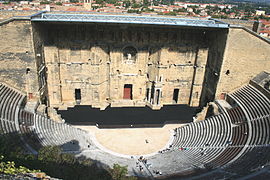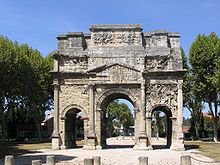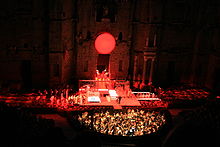- Orange, Vaucluse
-
Orange
Roman theatre 
Administration Country France Region Provence-Alpes-Côte d'Azur Department Vaucluse Arrondissement Avignon Canton Orange-Est and Orange-Ouest Mayor Jacques Bompard
(2008–2014)Statistics Elevation 24–127 m (79–417 ft)
(avg. 50 m/160 ft)Land area1 74.2 km2 (28.6 sq mi) Population2 30,025 (2007) - Density 405 /km2 (1,050 /sq mi) INSEE/Postal code 84087/ 84100 1 French Land Register data, which excludes lakes, ponds, glaciers > 1 km² (0.386 sq mi or 247 acres) and river estuaries. 2 Population without double counting: residents of multiple communes (e.g., students and military personnel) only counted once. Coordinates: 44°08′18″N 4°48′35″E / 44.138334°N 4.809723°E
Roman Theatre and its Surroundings and the Triumphal Arch of Orange * UNESCO World Heritage SiteCountry France Type Cultural Criteria iii, vi Reference 163 Region ** Europe and North America Inscription history Inscription 1981 (5th Session) * Name as inscribed on World Heritage List
** Region as classified by UNESCOOrange (Provençal Occitan: Aurenja in classical norm or Aurenjo in Mistralian norm) is a commune in the Vaucluse department in the Provence-Alpes-Côte d'Azur region in southeastern France.
It has a primarily agricultural economy. It is located about 21 km north of Avignon.
Contents
History
Roman Orange was founded in 35 BC by veterans of the Second legion[citation needed] as Arausio (after the local Celtic water god), or Colonia Julia Firma Secundanorum Arausio in full, "the Julian colony of Arausio established by the soldiers of the second legion." The name was originally unrelated to that of the orange fruit (Sanskrit nāraṅgaḥ), but was later conflated with it. (see Orange (word))
A previous Celtic settlement with that name existed in the same place and a major battle, which is generally known as the Battle of Arausio, had been fought in 105 BC between two Roman armies and the Cimbri and Teutones tribes.
Arausio covered an area of some 170 acres (69 ha) and was well endowed with civic monuments - as well as the theatre and arch, it had a monumental temple complex and a forum.
It was the capital of a wide area of northern Provence, which was parcelled up into lots for the Roman colonists. "Orange of two thousand years ago was a miniature Rome, complete with many of the public buildings that would have been familiar to a citizen of the Roman Empire, except that the scale of the buildings had been reduced -- a smaller theater to accommodate a smaller population, for example."[1]
The town prospered. It was sacked by the Visigoths in 412. It became a bishopric in the fourth century, and the hill fort of the Celtic Cavares was renamed for Saint Eutrope, the first bishop of Saintes. Christian Orange hosted two synods, in 441 and 529. The latter of the Councils of Orange was of importance in condemning the Pelagian heresy. The Diocese of Orange persisted until the French Revolution, and was formally suppressed in 1801.
The sovereign Carolingian counts of Orange had their origin in the eighth century, and passed into the family of the lords of Baux. The Baux counts of Orange became fully independent with the breakup of the Kingdom of Arles after 1033. From the twelfth century, Orange was raised to a minor principality, the Principality of Orange, as a fief of the Holy Roman Empire. During this period the town and the principality of Orange belonged to the administration and province of Dauphiné.
When William the Silent, count of Nassau, with estates in the Netherlands, inherited the title Prince of Orange in 1544, the Principality was incorporated into the holdings of what became the House of Orange-Nassau. This pitched it into the Protestant side in the Wars of Religion, during which the town was badly damaged. In 1568 the Eighty Years' War began with William as stadtholder leading the bid for independence from Spain. William the Silent was assassinated in Delft in 1584. It was his son, Maurice of Nassau (Prince of Orange after his elder brother died in 1618), with the help of Johan van Oldenbarnevelt, who solidified the independence of the Dutch republic. The United Provinces survived to become the Netherlands, which is still ruled by the House of Orange-Nassau. William, Prince of Orange, ruled England as William III of England. Orange gave its name to other Dutch-influenced parts of the world, such as the Orange Free State in South Africa.
The city remained part of scattered Nassau holdings until it was captured by the forces of Louis XIV in 1672 during the Franco-Dutch War, again captured in August 1682 and was finally ceded to France in 1713 under the Treaty of Utrecht that ended the wars of Louis XIV. Following the French Revolution of 1789, Orange was absorbed into the French département of Drôme, then Bouches-du-Rhône, then finally Vaucluse. However, the title remained with the Dutch Princes of Orange.
Orange attracted international attention in the 1990s, when it elected a member of the far right-wing Front National as its mayor. It is now run by Jacques Bompard, a member of the conservative Movement for France which he joined after having resigned from the Front National.
Orange is also home to the French Foreign Legion's armored 1er REC or First Foreign Cavalry Regiment.
Main sights
The town is renowned for its Roman architecture and its Roman theatre is described as the most impressive still existing in Europe. The fine Triumphal Arch of Orange is often said to date from the time of Augustus or Tiberius, but is probably much later, perhaps Severan.[2] The arch, theatre and surroundings were listed in 1981 by UNESCO as a World Heritage Site.
The Musée (Museum) displays the biggest (7.56 x 5.90 m) cadastral Roman maps ever recovered, etched on marble. They cover the area between Orange, Nîmes and Montélimar.
Culture
In 1869, the Roman theatre was restored and has been the site of a music festival. The festival, given the name Chorégies d'Orange in 1902 has existed annually ever since, and is now famous as an international opera festival.
In 1971, the "New Chorégies" were started and became an overnight, international success. Many top international opera singers have performed in the theatre, such as Barbara Hendricks, Plácido Domingo, Montserrat Caballé, Roberto Alagna, René Pape and Inva Mula. Operas such as Tosca, Aida, Faust and Carmen have been staged here, many with a sumptuous staging and also receiving outstanding acclaim.
The Roman theatre is one of three heritages still having the Roman Wall.
Twin towns
Orange is twinned with:
 Byblos, Lebanon, since 2004
Byblos, Lebanon, since 2004 Jarosław, Poland, since 2000 [3]
Jarosław, Poland, since 2000 [3] Kielce, Poland, since 1992
Kielce, Poland, since 1992 Orange, United States
Orange, United States Rastatt, Germany, since 1965
Rastatt, Germany, since 1965 Spoleto, Italy, since 1981
Spoleto, Italy, since 1981 Vélez Rubio, Spain, since 2004
Vélez Rubio, Spain, since 2004 Vyškov, Czech Republic, since 1964
Vyškov, Czech Republic, since 1964 Weifang, China, since 2004
Weifang, China, since 2004
It is also member of the Association of Orange cities, together with:
 Breda, Netherlands
Breda, Netherlands Diest, Belgium
Diest, Belgium Dillenburg, Germany
Dillenburg, Germany
See also
References
- Notes
- ^ Ina Caro, "The Road from the Past: Traveling through History in France".
- ^ King, Anthony (1990). Roman Gaul and Germany. British Museum. pp. 76 & 80–81.
- ^ "Jarosław Official website - Partner Cities".
 (in Polish) © 2008 Urząd Miasta Jarosław. Ul. Rynek 1, 37-500 Jarosław. http://www.jaroslaw.pl/miasta-partnerskie. Retrieved 2008-10-23.
(in Polish) © 2008 Urząd Miasta Jarosław. Ul. Rynek 1, 37-500 Jarosław. http://www.jaroslaw.pl/miasta-partnerskie. Retrieved 2008-10-23.
External links
- Roman Theatre and Museum official website (English)
- Town council website (French)
Communes of the Vaucluse department  Althen-des-Paluds · Ansouis · Apt · Aubignan · Aurel · Auribeau · Avignon · Le Barroux · La Bastide-des-Jourdans · La Bastidonne · Le Beaucet · Beaumes-de-Venise · Beaumettes · Beaumont-de-Pertuis · Beaumont-du-Ventoux · Bédarrides · Bédoin · Blauvac · Bollène · Bonnieux · Brantes · Buisson · Buoux · Cabrières-d'Aigues · Cabrières-d'Avignon · Cadenet · Caderousse · Cairanne · Camaret-sur-Aigues · Caromb · Carpentras · Caseneuve · Castellet · Caumont-sur-Durance · Cavaillon · Châteauneuf-de-Gadagne · Châteauneuf-du-Pape · Cheval-Blanc · Courthézon · Crestet · Crillon-le-Brave · Cucuron · Entraigues-sur-la-Sorgue · Entrechaux · Faucon · Flassan · Fontaine-de-Vaucluse · Gargas · Gignac · Gigondas · Gordes · Goult · Grambois · Grillon · L'Isle-sur-la-Sorgue · Jonquerettes · Jonquières · Joucas · Lacoste · Lafare · Lagarde-d'Apt · Lagarde-Paréol · Lagnes · Lamotte-du-Rhône · Lapalud · Lauris · Lioux · Loriol-du-Comtat · Lourmarin · Malaucène · Malemort-du-Comtat · Maubec · Mazan · Ménerbes · Mérindol · Méthamis · Mirabeau · Modène · Mondragon · Monieux · Monteux · Morières-lès-Avignon · Mormoiron · Mornas · La Motte-d'Aigues · Murs · Oppède · Orange · Pernes-les-Fontaines · Pertuis · Peypin-d'Aigues · Piolenc · Le Pontet · Puget · Puyméras · Puyvert · Rasteau · Richerenches · Roaix · Robion · La Roque-Alric · La Roque-sur-Pernes · Roussillon · Rustrel · Sablet · Saignon · Saint-Christol · Saint-Didier · Sainte-Cécile-les-Vignes · Saint-Hippolyte-le-Graveyron · Saint-Léger-du-Ventoux · Saint-Marcellin-lès-Vaison · Saint-Martin-de-Castillon · Saint-Martin-de-la-Brasque · Saint-Pantaléon · Saint-Pierre-de-Vassols · Saint-Romain-en-Viennois · Saint-Roman-de-Malegarde · Saint-Saturnin-lès-Apt · Saint-Saturnin-lès-Avignon · Saint-Trinit · Sannes · Sarrians · Sault · Saumane-de-Vaucluse · Savoillan · Séguret · Sérignan-du-Comtat · Sivergues · Sorgues · Suzette · Taillades · Le Thor · La Tour-d'Aigues · Travaillan · Uchaux · Vacqueyras · Vaison-la-Romaine · Valréas · Vaugines · Vedène · Velleron · Venasque · Viens · Villars · Villedieu · Villelaure · Villes-sur-Auzon · Violès · Visan · Vitrolles-en-LubéronCategories:
Althen-des-Paluds · Ansouis · Apt · Aubignan · Aurel · Auribeau · Avignon · Le Barroux · La Bastide-des-Jourdans · La Bastidonne · Le Beaucet · Beaumes-de-Venise · Beaumettes · Beaumont-de-Pertuis · Beaumont-du-Ventoux · Bédarrides · Bédoin · Blauvac · Bollène · Bonnieux · Brantes · Buisson · Buoux · Cabrières-d'Aigues · Cabrières-d'Avignon · Cadenet · Caderousse · Cairanne · Camaret-sur-Aigues · Caromb · Carpentras · Caseneuve · Castellet · Caumont-sur-Durance · Cavaillon · Châteauneuf-de-Gadagne · Châteauneuf-du-Pape · Cheval-Blanc · Courthézon · Crestet · Crillon-le-Brave · Cucuron · Entraigues-sur-la-Sorgue · Entrechaux · Faucon · Flassan · Fontaine-de-Vaucluse · Gargas · Gignac · Gigondas · Gordes · Goult · Grambois · Grillon · L'Isle-sur-la-Sorgue · Jonquerettes · Jonquières · Joucas · Lacoste · Lafare · Lagarde-d'Apt · Lagarde-Paréol · Lagnes · Lamotte-du-Rhône · Lapalud · Lauris · Lioux · Loriol-du-Comtat · Lourmarin · Malaucène · Malemort-du-Comtat · Maubec · Mazan · Ménerbes · Mérindol · Méthamis · Mirabeau · Modène · Mondragon · Monieux · Monteux · Morières-lès-Avignon · Mormoiron · Mornas · La Motte-d'Aigues · Murs · Oppède · Orange · Pernes-les-Fontaines · Pertuis · Peypin-d'Aigues · Piolenc · Le Pontet · Puget · Puyméras · Puyvert · Rasteau · Richerenches · Roaix · Robion · La Roque-Alric · La Roque-sur-Pernes · Roussillon · Rustrel · Sablet · Saignon · Saint-Christol · Saint-Didier · Sainte-Cécile-les-Vignes · Saint-Hippolyte-le-Graveyron · Saint-Léger-du-Ventoux · Saint-Marcellin-lès-Vaison · Saint-Martin-de-Castillon · Saint-Martin-de-la-Brasque · Saint-Pantaléon · Saint-Pierre-de-Vassols · Saint-Romain-en-Viennois · Saint-Roman-de-Malegarde · Saint-Saturnin-lès-Apt · Saint-Saturnin-lès-Avignon · Saint-Trinit · Sannes · Sarrians · Sault · Saumane-de-Vaucluse · Savoillan · Séguret · Sérignan-du-Comtat · Sivergues · Sorgues · Suzette · Taillades · Le Thor · La Tour-d'Aigues · Travaillan · Uchaux · Vacqueyras · Vaison-la-Romaine · Valréas · Vaugines · Vedène · Velleron · Venasque · Viens · Villars · Villedieu · Villelaure · Villes-sur-Auzon · Violès · Visan · Vitrolles-en-LubéronCategories:- Archaeological sites in France
- Roman towns and cities in Provence
- Communes of Vaucluse
- World Heritage Sites in France
- 35 BC establishments
Wikimedia Foundation. 2010.




